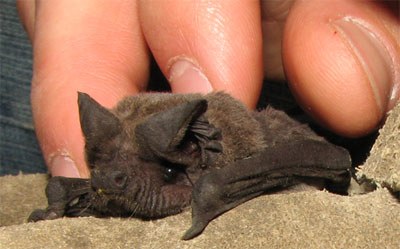Identification pointers
This is a small, dark-coloured bat, with a fast flying pattern rather than fluttering. The fur above is dark brown and may appear black in low light; the tummy and chest below can vary from white to cream or light grey. Two light grey or white bands run parallel along the sides of the body, from the base of the wing arms to the legs; a light band of fur may also be present on the inner wing membrane from the elbow of the wing to the thigh. Colour of fur is very variable. It has slightly wrinkled lips and upright, forwardly ears that are large relative to its head. All skin and wing membranes are dark coloured. Chattering, squeaky sounds are clearly audible a few minutes before dusk where large colonies roost.
The forearm length varies from 35-46 mm and the their mass is a mere 7.8-16 grams.
Roosting habits
They roost in a variety of crevices, in rocks (especially granite outcrops), under the bark of trees or, most commonly, in the roofs of houses. They may form large colonies of up to hundreds in some regions of South Africa. They often use very small entrance or exit holes that are found between brickwork and corrugated iron, or even spaces between the tiles of a roof. During the summer months in South Africa’s hotter regions the temperatures inside such corrugated iron roofs are very high, and the sun may warm this corrugated iron to temperatures that can inflict burn wounds if touched for only a few seconds. In Mooketsi (Limpopo province near Tzaneen) a corrugated iron roof of a house was occupied by this species and atmospheric temperatures in the roost, measured over 25 days in February, had an average of 30.3 °C, and ranged from 19.4°C to 48.1°C. Clearly these bats have a tolerance for a wide range of temperatures.
Large colonies living in a house roof may become a nuisance due to their noisy behaviour and an odour that may be present, but fortunately EcoSolutions can supply bat houses suitable for this species and have the expertise to exclude them from your house roof. In this way you can still have a large insect-eating colony in your garden but the drawback of a smelly ceiling is eliminated.
Breeding
Three births per year in early November, late January and early April (in Southern Africa), where a single young is born per birth. Due to its fast reproduction this makes this species an effective biological control method for insects. Females are sexually mature at an age of 5-12 months.
Food
In order of priority they feed on beetles, plant-sucking bugs, moths, Hymenoptera (probably nocturnal wasps or flying ants), mosquitoes and nocturnal flies.






